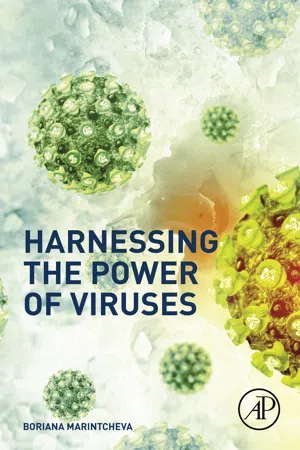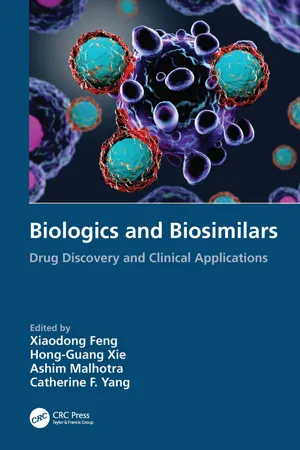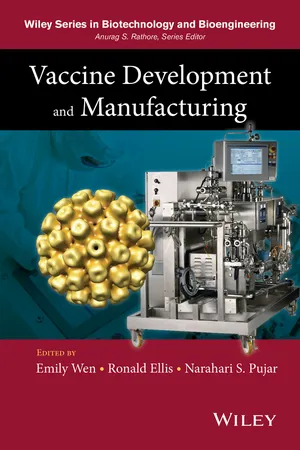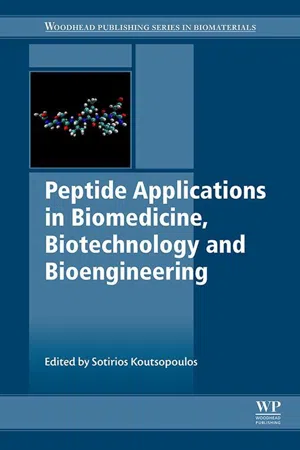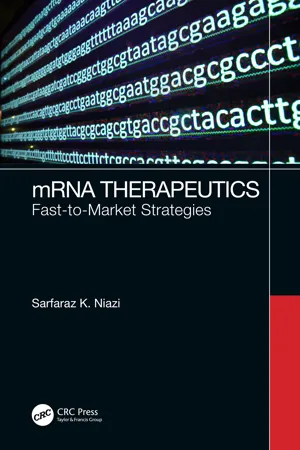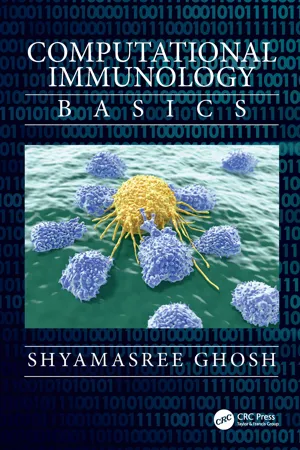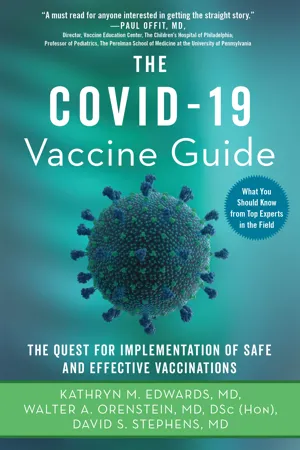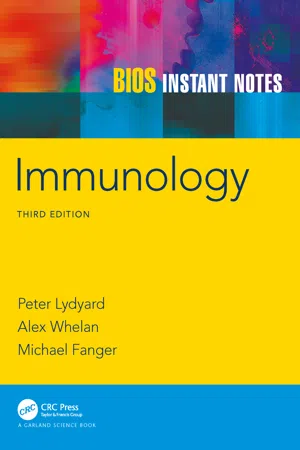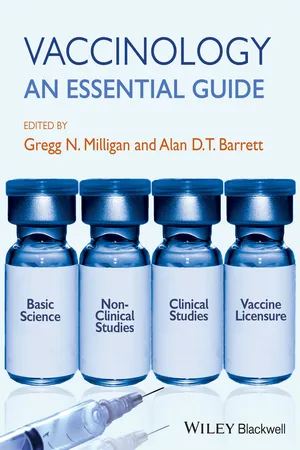Biological Sciences
Subunit Vaccine
A subunit vaccine is a type of vaccine that contains only specific antigens or parts of a pathogen, rather than the whole pathogen. These antigens stimulate an immune response in the body, leading to the production of antibodies and memory cells. Subunit vaccines are often safer than traditional vaccines because they do not contain live or whole pathogens.
Written by Perlego with AI-assistance
Related key terms
9 Key excerpts on "Subunit Vaccine"
- eBook - ePub
- Boriana Marintcheva(Author)
- 2017(Publication Date)
- Academic Press(Publisher)
Depending on their composition, classical vaccines can be viewed as whole-agent vaccines or subunit/component vaccines. Whole-agent vaccines contain a safe form of the actual pathogen causing the disease the vaccine is preventing. The infectious agent is either dead (inactivated vaccines), killed by heat, chemical treatment, etc., or alive but in weakened form (attenuated vaccines). Advantage of whole vaccines is that they mimic the infectious agent best, triggering the rise of a range of antibodies with various specificities. Dead vaccines cannot cause disease; however, they cannot induce cellular immunity either, since no productive infection takes place. Attenuated vaccines can cause full-blown infection, thus the immune response is more robust and involves both humoral and cellular components. The infection itself is very mild and does not present health concerns except in immunocompromised individuals and pregnant women. A classical approach to create an attenuated vaccine strain is to subject a wild type strain to multiple passages while monitoring virulence and immunogenicity. This strategy takes advantage of the natural ability of viruses to mutate, and depending on the mechanism of attenuation, reversions to WT virus might be of concern. Attenuated strains with deletion mutations are preferred in comparison to ones with point mutations since reversion back to WT is physically impossible. Usage of whole-agent vaccines is somewhat restricted by the ability to grow unlimited amounts of viruses in tissue culture, as well as the need for refrigeration and preservatives for long-term storage.Subunit Vaccines consist of single components of the pathogen in question, cannot cause disease, and elicit mainly humoral immune response. Subunit Vaccines can be composed of inactivated toxins (toxoid vaccines against toxin-producing bacteria); surface molecules of pathogens (hemagglutinin and neuraminidase–based antiflu vaccine); or empty viral capsids (Gardasil/anti-HPV vaccine), etc. Subunit Vaccines generally require multiple booster injections to ensure strong protection. Today, most of the Subunit Vaccines conferring antiviral protection consist of recombinant proteins and are thus also classified as recombinant Subunit Vaccines. Not that long time ago such vaccines were considered experimental; however, at this moment the use of genetic engineering to produce large quantities of the protein of interest presents a rather standard practice and of course a great example of how science advancement positively impacts our life.Conjugate vaccines could be considered as a special case of Subunit Vaccines, mainly applicable to bacterial pathogens. Polysaccharides from the outer surface of bacteria are attached/conjugated to inactivated protein toxins and used for vaccination. The approach solves the problem with the relatively low immunogenicity of the polysaccharides and “forces” the immune system to execute a robust humoral response against them using the toxin molecule as a tool.8.4.2. Experimental Vaccines
Many of the classical vaccines used today were originally developed around the mid-20th century. Despite the fact that they are continuously reevaluated and refined, the magnitude of change is not even a close match to the advancement of molecular biology and biotechnology approaches relevant to vaccine design and manufacturing. While there is no obvious reason to seek replacement of effective and safe vaccines, it is only for natural new technologies to change the landscape of the field. Efforts are currently focused on creating vaccines eliciting strong cellular and humoral responses, lowering the cost of production, and increasing vaccine shelf lives, along with developing alternative delivery mechanisms. A major trend in vaccine production is moving manufacturing outside animal cells and utilizing plant, bacterial and fungal model systems. The latter are not only more cost-efficient but also eliminate the danger of pathogen cross-contamination, which is a constant concern when vaccines are produced in tissue culture, especially if mammalian cells are used. - eBook - ePub
Biologics and Biosimilars
Drug Discovery and Clinical Applications
- Xiaodong Feng, Hong-Guang Xie, Ashim Malhotra, Catherine F. Yang, Xiaodong Feng, Hong-Guang Xie, Ashim Malhotra, Catherine F. Yang(Authors)
- 2022(Publication Date)
- CRC Press(Publisher)
C. difficile require booster injections due to poor immunogenicity [27, 48].4.5.3.2 Protein Subunit Vaccines
Protein Subunit Vaccines consist of an antigenic protein from the pathogen of interest coupled to an adjuvant to induce an immune response [27] and subsequently offer protection to the host from the wild-type pathogen. Choice of the microbial protein requires identification of the microbial components that are responsible for protective immunity. Likewise, when constructing the adjuvant, special care is taken to identify proper stabilizers, an effective delivery system, and optimal immunogenicity. Following stringent purification processes, the immune response can be “customized” by optimization of the vaccine delivery systems. A thorough understanding of the tailored immune response to the wild-type pathogen is required, otherwise, resultant immunity could be inadequate. For example, alum is a commonly used adjuvant due to its safety; however, it is a relatively weak inducer of the immune response [44].Though protein Subunit Vaccines may produce reduced immune responses, their safety compared to live attenuated vaccines have led to their use and subsequent success in preventing prominent viral diseases. The hepatitis B vaccine utilizes the hepatitis B surface antigen (HBsAg) and the HPV vaccine utilizes the HPV-6 L1 capsid protein to generate protective immunity in the host [36]. In more recent news, protein Subunit Vaccines synthesized by Anhui Zhifei Longcom and FBRI utilize the SARS-CoV-2 spike protein and have been approved for use in at least two countries to help prevent COVID-19 [34].4.5.3.3 Polysaccharide Subunit Vaccines
When constructing a Subunit Vaccine, or any vaccine for that matter, it is important to consider the stage of the infection in which to target with an immune response. To minimize the host cell death, many vaccines attempt to induce an immune response against pathogenic entry mechanisms [49 –51 - eBook - ePub
- Emily P. Wen, Ronald Ellis, Narahari S. Pujar, Emily P. Wen, Ronald Ellis, Narahari S. Pujar(Authors)
- 2014(Publication Date)
- Wiley(Publisher)
Chapter 4 Novel Expression Systems for Vaccine ProductionSHAILAJA RABINDRANUS Department of Agriculture Animal and Plant Health Inspection Service, Riverdale, MD, USAVIDADI YUSIBOVFraunhofer USA Center for Molecular Biotechnology, Newark, DE, USA4.1 Introduction
In 1796, when Edward Jenner demonstrated protection of individuals against smallpox after inoculation with cowpox virus, he established vaccines as an effective tool to combat infectious diseases. Since then, there has been significant progress in vaccine development, evolving from full pathogen-based, killed or live-attenuated, vaccines to Subunit Vaccines. Although 25–30 vaccines are now licensed for use in humans, developing a vaccine against every new pathogen continues to be a paramount challenge, and the global need for vaccines continues to grow. With advances in genomics and proteomics, there has been an explosion in new knowledge that has enabled better understanding of the molecular pathways underlying pathogenesis, the host immune system, and host–pathogen interactions. This new knowledge, coupled with the development of new and highly efficient production technologies, has created opportunities for the design and manufacture of new Subunit Vaccines and has ushered in a renaissance in the field of vaccinology.4.2 Subunit Vaccines
Although a majority of currently licensed vaccines is based on killed or live-attenuated pathogens, Subunit Vaccines that rely on specific antigens or toxins that induce protective immunity are becoming preferred alternatives. This is because recombinant Subunit Vaccines are safe and effective, and their production can be easily scaled-up.Initially, Subunit Vaccines were based on toxins purified from culture supernatants of host organisms, such as tetanus and diphtheria toxins. With better understanding of the molecular basis of pathogenesis and with the availability of new methodologies, conjugate vaccines then emerged as a new class of Subunit Vaccines, in which protective immunity is generated by a polysaccharide molecule coupled to a protein carrier. Vaccines against Haemophilus influenza type B or Neisseria meningitidis - Sotirios Koutsopoulos(Author)
- 2017(Publication Date)
- Woodhead Publishing(Publisher)
Live vaccines are usually highly immunogenic, do not require a boost, and can produce humoral and cellular immune responses. However, these vaccines are not stable and require storage at a consistent cold temperature—“cold chain.” Attenuated pathogens can undergo secondary mutation and revert to their virulent form leading to severe complications, especially in the case of immunocompromised patients. Killed or inactivated vaccines are more stable and safer; but generate a relatively weaker immune response and require additional boosts to induce the desired protection. All of these vaccines also possess a questionable safety profile due to the potential risk of inducing autoimmunity or strong allergic reactions. The lack of technology to produce some of the pathogens in large quantities and problems associated with purification of biological materials limit the use of whole organisms in the development of vaccines. These limitations have led to the generation of highly purified Subunit Vaccines that contain the minimum part of the pathogen necessary to evoke an effective immune response [4]. Subunit Vaccines can be composed of polysaccharides (e.g., meningococcal vaccines Mencevax ACWY and Menomune), proteins (e.g., acellular pertussis (aP), and hepatitis B vaccines), or their peptide fragments. These vaccines are safer because they lack any live components and therefore cannot cause disease. They can induce a controlled immune response and the risk of autoimmunity and allergic responses is greatly reduced. 12.2 Peptide-based vaccines Although protein- and polysaccharide-based vaccines have been developed, further improvements in vaccine stability, selectivity, and reduction of any undesired immune response could be achieved using peptide-based vaccines. As the name suggests, these vaccines are based on peptide epitopes, which are minimum components necessary for pathogen recognition [5]- eBook - ePub
mRNA Therapeutics
Fast-to-Market Strategies
- Sarfaraz K. Niazi(Author)
- 2022(Publication Date)
- CRC Press(Publisher)
Figure 4.1 ). Key milestones include the development of virus-like particle vaccines, recombinant viral-vectored vaccines, and toxoids, polysaccharides, or protein-based vaccines, which can be conjugated with different protein carriers to improve immune response.FIGURE 4.1 Vaccination targets and milestones.Toxoid vaccines stimulate an immunological response by using a bacteria's toxin. Researchers discovered that exposing guinea pigs to diphtheria toxins helped prevent diphtheria infection in the early 1900s, which led to the development of these vaccinations. The pathogen can be recognized and removed by educating the immune system to recognize a toxin produced by a pathogen. Diphtheria is still prevented by toxoid vaccinations. Meanwhile, a Subunit Vaccine is a component of a pathogen, a protein, sugar, or a bit of the pathogen’s shell, known as a capsid, that is used to train the immune system. While these vaccines produce powerful reactions to the part of the pathogen delivered, they do not produce significant reactions if the virus mutates, which is exceedingly improbable. Because of their robustness and stability, vaccines that have been attenuated or inactivated in the past, such as Bacillus Calmette–Guérin vaccine (BCG) and Inactivated Polio vaccine (IPV), are frequently utilized. However, because they use whole viruses and, in many cases, lack recognizable traits, they create safety concerns.Vaccines developed on the basis of traditional technology have failed, such as those developed for malaria, tuberculosis, AIDS, or flu. Furthermore, SARS and Ebola epidemic outbreaks and, more recently, the COVID-19 pandemic show that many of the current platforms are not well suited for a fast, efficient, and cost-effective response. - eBook - ePub
Computational Immunology
Basics
- Shyamasree Ghosh(Author)
- 2019(Publication Date)
- CRC Press(Publisher)
Design of liposomes and incorporation of protein antigens into micelles or lipid vesicles or immunostimulating complexes or by mixing proteins in detergents with the subsequent removal of the detergent forming micelles are some strategies of vaccine design. The hydrophilic residues of proteins, orient towards the aqueous environment and the hydrophobic residues towards the centre. Liposomes containing protein antigen are prepared by mixing proteins with phospholipid suspension forming lipid bilayer vesicles. Incorporation of proteins into the bilayer with the hydrophilic residues exposed can be designed. Immunostimulating complexes (ISCOMs) are lipid carriers prepared by mixing protein with detergents and a glycoside termed Quil A. Membrane proteins from pathogens including influenza virus, measles virus, hepatitis B virus, and HIV have been used in design of vaccines in the form of micelles, liposomes, and ISCOMs. ISCOMs have the advantage of increased immunogenicity, and they can fuse with the plasma membrane to deliver the antigens intracellularly where it can be processed by the cytosolic pathway and thus induce CMI responses.8.7 VACCINES APPROVED BY THE U.S. FOOD AND DRUG ADMINISTRATION
Research and development of design of vaccines against several disorders are still ongoing across the globe. The Office of Vaccines Research and Review (OVRR) at the Centre for Biologics Evaluation and Research (CBER) at FD regulates preventative and therapeutic vaccines for human diseases [5 ]. The US. Food and Drug Administration (FDA) has approved several vaccines (Table 8.5 ).8.8 VACCINES UNDER DEVELOPMENT
Different types of vaccine are being developed for the prevention of infectious diseases by triggering innate immune system and both arms of the adaptive immune system [7 ]. First, live, attenuated vaccines against measles, mumps, and chickenpox contain attenuated versions of the original pathogenic agent, producing a strong cellular and antibody responses and long-term memory. Inactivated vaccines like inactivated influenza vaccine produced by treating a pathogenic agent with chemicals, heat, or radiation increases stability but produce weaker immune responses and require booster shots to maintain immunity [8 ]. Subunit Vaccines like recombinant hepatitis B vaccine include only epitopes that readily stimulate the immune system, and does not reveal adverse reactions. Toxoid vaccines like diphtheria and tetanus vaccines produced by inactivating bacterial toxins with formalin stimulate an immune response against the bacterial toxins. Conjugate vaccines like the Haemophilus influenzae type B (Hib) vaccine is a type of Subunit Vaccine in which the antigens or toxoids are linked to polysaccharides from the outer coating of that microbe to stimulate immunity. Naked DNA vaccines that stimulate immunity and is largely under research. The host cells producing the antigen and displaying it on their surfaces would stimulate the immune system to produce a strong humoral and cellular response to the microbial antigens. Naked DNA vaccines for influenza and herpes are being developed [9 ]. Recombinant vector vaccines are designed to deliver either an attenuated virus or microbe into host cells, mimicking a natural infection process. These antigens from the pathogenic microbe would be displayed on harmless microbe mimicking the pathogen and stimulating the immune system. Bacterial and viral-based recombinant vectors vaccines for HIV, rabies, and measles are being designed [9 ]. Attempts are being made for improvising the adjuvants, either by delivery systems like cationic microparticles or immune potentiators like cytokines or PRRs [10 - eBook - ePub
The Covid-19 Vaccine Guide
The Quest for Implementation of Safe and Effective Vaccinations
- Kathryn M. Edwards, Walter A. Orenstein, David S. Stephens(Authors)
- 2021(Publication Date)
- Skyhorse(Publisher)
Chapter 2 Introduction to Vaccines and VaccinologyV accines are the most cost-effective intervention for preventing human disease. What is a vaccine? How does it work? How do vaccines protect?A vaccine is a substance, such as an inactivated protein from an infectious organism, that when given to a person induces an active immune response to prevent or mitigate a disease. Your immune system acts as an army. The immune system ideally detects the foreign invading germ (i.e., virus, bacterium, fungus), generally called a “pathogen,” and destroys it or contains it so that it cannot cause disease. What a vaccine does is give the immune system practice so that when it encounters the real pathogen, it is ready. Without practice from the vaccine, the pathogen can overwhelm an unprepared immune system, causing serious illness.The immune system can protect against infection and disease in two different ways. First, it can secrete immune proteins, called antibodies, into blood or tissues that bind to the invading pathogen and prevent it from multiplying or invading cells of the human body and enhancing the uptake of the pathogens into special cells (“phagocytes”) which destroy the pathogen. This aspect of the immune system is often called the humoral immune system. Critical players in this response are B cells and specialized B cells called plasma cells. The plasma cells produce the antibodies that circulate in the blood and other body fluids and tissues, which when encountering the pathogen neutralize it or bind to it, facilitating destruction of the pathogen by other cells of the immune system.Second, the immune system consists of specialized cells, called T cells, which destroy infected human cells and prevent the pathogen from spreading and causing serious disease. This aspect of the immune system is called the cellular immune system.A number of vaccines include substances called adjuvants or immune system helpers. These adjuvants enhance the immune response to the vaccine. In the United States, the most common adjuvants are aluminum-based compounds. But an increasing number of vaccines have other new adjuvants that stimulate immunity, particularly in the elderly or those with less-robust immune responses (see https://www.cdc.gov/vaccinesafety/concerns/adjuvants.html - eBook - ePub
- Peter Lydyard, Alex Whelan, Michael Fanger(Authors)
- 2011(Publication Date)
- Taylor & Francis(Publisher)
Using molecular genetics, selective recombinant proteins with defined epitopes can be prepared that can induce protective immunity to pathogens. This approach overcomes the problem of disease complications that may occur with modified live vaccines. Nanoparticle vaccines Nanoparticles consisting of synthetic resins, polystyrenes, carbon particles, silica, iron, or polyethylenes are currently being investigated for suitability as adjuvants in vaccine delivery. They offer potential advantages over current vaccines in that they are easily manipulated and may be given through the mucosal route or systemically. Cytokines Cytokines can be added at the time of immunization to skew the immune response to a Th1- or Th2-type response depending on the kind of response needed for protection against a particular pathogen. Cytokines that might be useful are IL-12 or IFNγ, which favor a Th1 response, or IL-4 and IL-10, which favor a Th2 response. Related topics (B2) Molecules of the innate immune system (E3) The cellular basis of the antibody responseAntigen preparations
The protective immune response to pathogenic microorganisms requires the generation of specific T- and B-cell responses and appropriate effector mechanisms. In order to do this, vaccines must be capable of targeting the immune system appropriately. In principle anything from whole organisms to small peptides can be used, but in practice most vaccines consist of attenuated live organisms, killed organisms, inactivated toxins, or subcellular fragments (Table 1 ).Table 1. Antigen preparations used in vaccinesType of antigen Viruses Bacteria Normal heterologous organism Vaccinia (cowpox) Living attenuated organism Measles BCG Mumps Typhoid (new) Rubella Polio: Sabin Yellow fever Varicella-zoster Whole killed organism Rabies Pertussis Polio: Salk Typhoid Influenza Cholera Subcellular fragment Inactivated toxin (toxoid) Diphtheria Tetanus Cholera (new) Capsular polysaccharide Meningococcus Pneumococcus Haemophilus Typhoid (new) Surface antigen Hepatitis B There is also a fundamental distinction between live and dead vaccines. Living and non-living vaccines differ in many important respects, notably safety and effectiveness. Many live vaccine organisms (mostly viruses) have been attenuated by growth under conditions that result in mutants that have lost virulence but retain antigenicity. Currently, mutation is usually “site-directed” using recombinant DNA technology. These mutant (modified-live) organisms are essentially new strains. They often induce stronger and better localized immunity, do not often require adjuvants or “booster” injections and provide the possibility of “herd” immunity in that mutated nonvirulent virus could be transferred to nonimmunized individuals in a local community. Moreover, the immunity induced, for example Th1 versus Th2 responses, is usually more appropriate for protection against the pathogenic strain of the organism. On the other hand, live attenuated vaccines can sometimes regain virulence by back-mutation - eBook - ePub
Vaccinology
An Essential Guide
- Gregg N. Milligan, Alan D. T. Barrett, Gregg N. Milligan, Alan D. T. Barrett(Authors)
- 2014(Publication Date)
- Wiley-Blackwell(Publisher)
Perhaps the advance that has most benefited vaccinology is the use of molecular biology techniques. These fundamental methods, developed in the 1970s, have driven the development of recombinant and Subunit Vaccines, allowing the production of vaccines for pathogens that cannot be grown for inactivation or attenuation by traditional methods. The first subunit recombinant vaccine was for hepatitis B, where hepatitis B surface antigen (HBsAg) was expressed in yeast and replaced hepatitis B particles that were purified from the plasma of infected individuals as the commercial vaccine.Modern molecular biology came of age with the discovery of the first restriction enzyme HindII in 1970, for which Nathans, Arber, and Smith were awarded the Nobel Prize for Physiology or Medicine in 1978. The ability to cut DNA at specific points, and ligate in new sequences with complementary “sticky ends” has proven extraordinarily useful in virtually every area of biology. The subsequent field of recombinant DNA technology has made possible the creation of hybrid genomes or plasmids containing elements selected to confer particular phenotypic characteristics to genomes with regions “knocked out” or replaced with other sequences. The application of this technology can be used to investigate experimental systems, such as constructing a fusion between a protein of interest and a fluorescent protein, facilitating visualization in an experiment, to creating hybrid viruses as candidate vaccines. The application of these techniques to vaccine design is discussed in a subsequent section.Mechanisms of Disease and Comparative Pathogenesis
Understanding the basic molecular mechanisms that are responsible for a disease can play a critically important role in vaccine development. Most vaccines do not require the microorganism to be eliminated in order to be effective. In certain cases, it is possible to separate the disease from the organism, and develop vaccines against the mechanisms that drive the pathology.A good example of this is the tetanus vaccine. This vaccine protects against the disease caused by Clostridium tetani, by raising an immune response, not against the bacterium, but against the toxin. Experiments in the 1880s demonstrated that C. tetani
Index pages curate the most relevant extracts from our library of academic textbooks. They’ve been created using an in-house natural language model (NLM), each adding context and meaning to key research topics.
